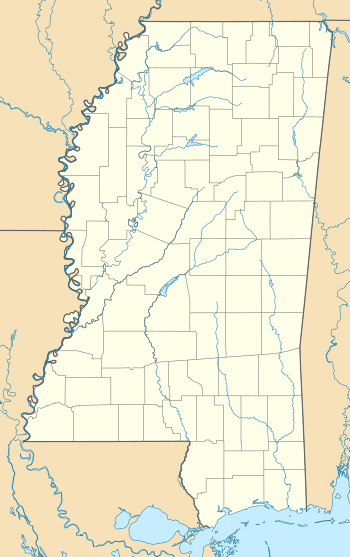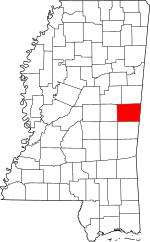Wahalak, Mississippi
Wahalak is a small unincorporated community in central Kemper County, Mississippi. It is best known as the temporary hideout of fugitive Kenny Wagner, who was on the FBI Ten Most Wanted Fugitives list in the 1950s.
Wahalak, Mississippi | |
|---|---|
 Wahalak Location in Mississippi and the United States  Wahalak Wahalak (the United States) | |
| Coordinates: 32°54′20″N 88°31′47″W | |
| Country | United States |
| State | Mississippi |
| County | Kemper |
| Time zone | UTC-6 (Central (CST)) |
| • Summer (DST) | UTC-5 (CDT) |
In late December 1906, Wahalak and Scooba, Mississippi, were the sites of white rioting against blacks. In the various conflicts, a total of 12 blacks and two whites were killed by December 26. The county sheriff called in the state militia for assistance.[1]
History
The name reputedly comes from a Choctaw language word meaning "running water". The settlement developed along what was known as Wahalak Creek. After the Mobile and Ohio Railroad was constructed through Kemper County later in the 19th century, this small settlement relocated several miles west in order to have access to it. The railroad built a train depot and a US post office was established for Wahalak.
Passenger trains serving the town included those known as the Doodlebug and the Rebel. In the early 20th century, residents could travel directly from Wahalak to such places as Memphis, Tennessee, on the Mississippi River to the north and Mobile, Alabama, on the Gulf Coast to the south.
After the discontinuation of passenger train service in the 1950s, due to a decline in demand as people bought cars and used federally subsidized highways, the village declined in population. The last Postmistress was Allene Bruton, who also ran a small general store. In the early 21st century, Wahalak has two churches and one restaurant.
Wahalak is remote even by Kemper County standards. It is in the near-geographic center between Meridian and Columbus, Mississippi. The nearest movie theaters or shopping malls are more than 45 miles away. The nearest soda vending machine is located in Scooba, 7 miles away.
References
- "Whites in Race War Kill Blacks Blindly/ Innocent Negroes Shot in the Mississippi Trouble", New York Times, December 26, 1906; accessed May 28, 2017.
